Page 292 of 398
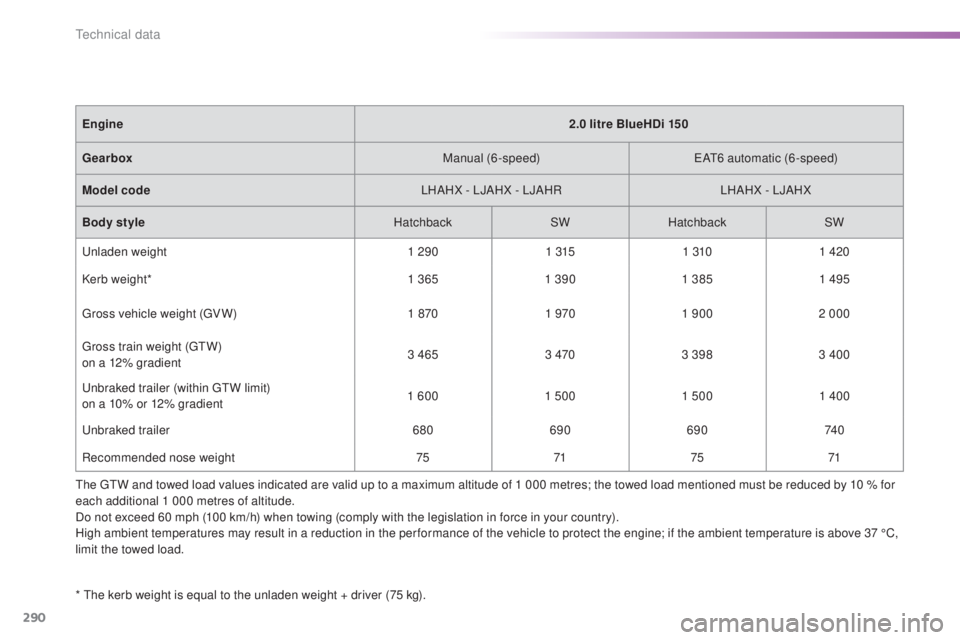
290
308_en_Chap09_caracteristiques-techniques_ed02-2015
* the kerb weight is equal to the unladen weight + driver (75 kg).
En gine
2.0 litre BlueHDi 150
Gearbox Manual (6-speed)
eAt6 au
tomatic (6-speed)
Model code LHAHX - LJAHX - LJAHRLHAHX - LJAHX
Body style HatchbackSWHatchback SW
unl
aden weight
1 2901 3151 3101 420
Kerb weight* 1 3651 390 1 3851 495
gro
ss vehicle weight (
gV W
)
1 8701 9701 900 2 000
gro
ss train weight (
gtW)
o
n a 12% gradient
3 465
3 4703 398 3 400
unb
raked trailer (within
g
t
W li
mit)
on a 10% or 12% gradient 1 600
1 5001 500 1 400
unbr
aked trailer
680690 690 74 0
Recommended nose weight 757175 71
the g
t
W an
d towed load values indicated are valid up to a maximum altitude of 1 000 metres; the towed load mentioned must be reduced by 10 % for
each additional 1 000 metres of altitude.
Do not exceed 60 mph (100 km/h) when towing (comply with the legislation in force in your country).
High ambient temperatures may result in a reduction in the per formance of the vehicle to protect the engine; if the ambient temperature is above 37 °C,
limit the towed load.
technical data
Page 293 of 398
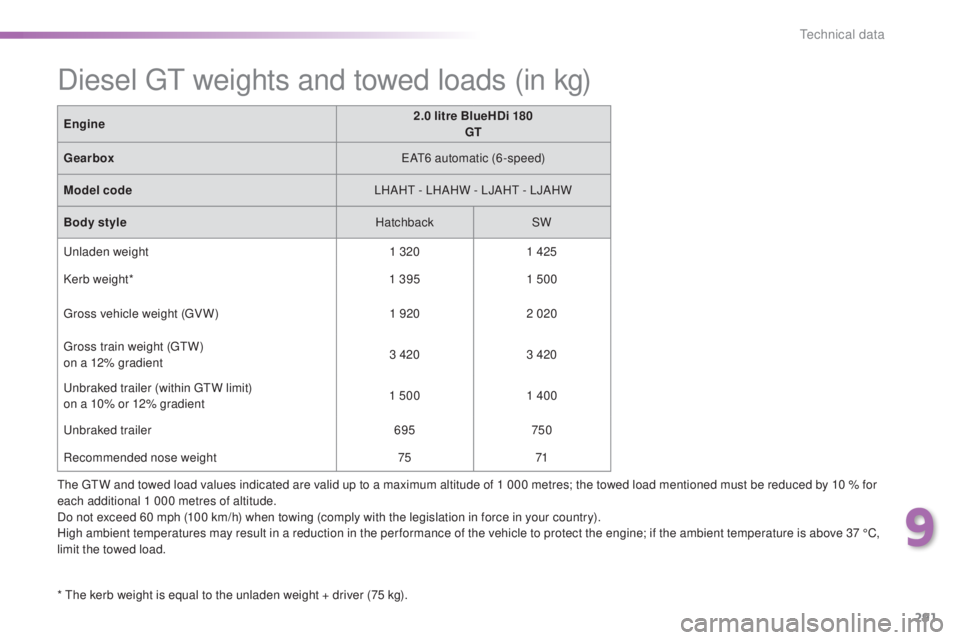
291
308_en_Chap09_caracteristiques-techniques_ed02-2015
the gtW and towed load values indicated are valid up to a maximum altitude of 1 000 metres; the towed load mentioned must be reduced by 10 % for
each additional 1 000 metres of altitude.
Do not exceed 60 mph (100 km/h) when towing (comply with the legislation in force in your country).
High ambient temperatures may result in a reduction in the per formance of the vehicle to protect the engine; if the ambient temperature is above 37 °C,
limit the towed load.
Diesel gt weights and towed loads (in kg)
* the kerb weight is equal to the unladen weight + driver (75 kg).
En gine
2.0 litre BlueHDi 180
GT
Gearbox
eAt6 au
tomatic (6-speed)
Model code LHAH
t - L
HAHW - LJAH
t - L
JAHW
Body style HatchbackSW
unl
aden weight
1 3201 425
Kerb weight* 1 3951 500
gro
ss vehicle weight (
gV W
)
1 9202 020
gro
ss train weight (
gtW)
o
n a 12% gradient
3 420
3 420
unb
raked trailer (within
g
t
W li
mit)
on a 10% or 12% gradient 1 500
1 400
unbr
aked trailer
695750
Recommended nose weight 7571
9
technical data
Page 301 of 398
299
308_en_Chap10c_SMegplus_ed02-2015
7-inch touch screen
GPS satellite navigation - Multimedia audio - Bluetooth® telephone
Contents
First steps 30 0
Steering mounted controls
30
3
Menus
3
04
Media
3
06
Radio
3
12
DAB (Digital Audio Broadcasting) radio
31
4
Music
3
16
Navigation
32
0
Navigation -
guid
ance
32
8
Traffic
332
C
onfiguration
33
4
Connected services
34
4
P
eu
ge
Ot C
onnect Apps
34
5
tele
phone
34
6
Frequently asked questions
35
4
the s
ystem is protected in such a way that it will only operate in
your vehicle. As a safety measure, the driver should only carry out operations
which require prolonged attention while the vehicle is stationary.
the d
isplay of the energy economy mode message signals
that the system is about to go into standby. Refer to the
ene
rgy
economy (mode) section.
.
Audio and telematics
Page 314 of 398

312
308_en_Chap10c_SMegplus_ed02-2015
Press on Media to display the
primary page. Press Media to display the primary
page then select " Preset".
If necessary, select change of
source. Press on Media
to display the
primary page.
By automatic frequency search
Select " Radio list " in the secondary
page. Select a preset radio station
in the list.
Select " FM Radio " or "AM Radio ".
Select a radio station from
the list offered.
Select " Update list " to refresh
the
l
ist.
Press on Media
to display the
primary page then go to the
secondary page.
Select " List" in the primary page.
Radio
Changing a radio frequency
Selecting a station
OR
orOR
the exterior environment (hills, buildings,
t unnel, car park, below ground...) may
prevent reception, even in RDS station
tracking mode.
thi
s phenomenon is
normal in the propagation of radio waves
and is in no way indicative of a fault with
the audio system.
or
Press 3 or 4 to move the cursor for an
automatic search down or up for a radio
frequency.Press on Media to display the
primary page then press on the
secondary page.
Press on " Enter frequency " to
display the primary page then press
on the secondary page.
Audio and telematics
Page 319 of 398
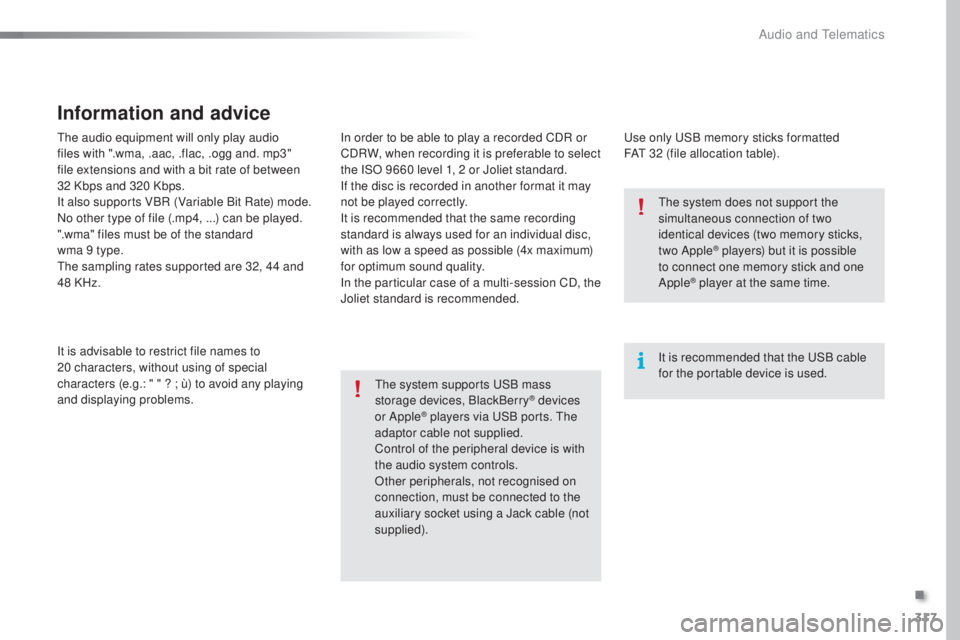
317
308_en_Chap10c_SMegplus_ed02-2015
the audio equipment will only play audio
f iles with ".wma, .aac, .flac, .ogg and. mp3"
file extensions and with a bit rate of between
32
K
bps and 320 Kbps.
It also supports VBR (Variable Bit Rate) mode.
No other type of file (.mp4, ...) can be played.
".wma" files must be of the standard
wma 9 type.
the s
ampling rates supported are 32, 44 and
48 KHz.
It is advisable to restrict file names to
20
c
haracters, without using of special
characters (e.g.: " " ? ; ù) to avoid any playing
and displaying problems.
Information and advice
use only uSB m emory sticks formatted
FAt 3 2 (file allocation table).
the s
ystem supports
uSB m
ass
storage devices, BlackBerry
® devices
or Apple® players via uSB p orts. the
a
daptor cable not supplied.
Control of the peripheral device is with
the audio system controls.
Other peripherals, not recognised on
connection, must be connected to the
auxiliary socket using a Jack cable (not
supplied). It is recommended that the
uSB c
able
for the portable device is used.
the s
ystem does not support the
simultaneous connection of two
identical devices (two memory sticks,
two Apple
® players) but it is possible
to c
onnect one memory stick and one
Apple
® player at the same time.
In order to be able to play a recorded CDR or
CDRW, when recording it is preferable to select
the ISO 9660 level 1, 2 or Joliet standard.
If the disc is recorded in another format it may
not be played correctly.
It is recommended that the same recording
standard is always used for an individual disc,
with as low a speed as possible (4x maximum)
for optimum sound quality.
In the particular case of a multi-session CD, the
Joliet standard is recommended.
.
Audio and telematics
Page 320 of 398
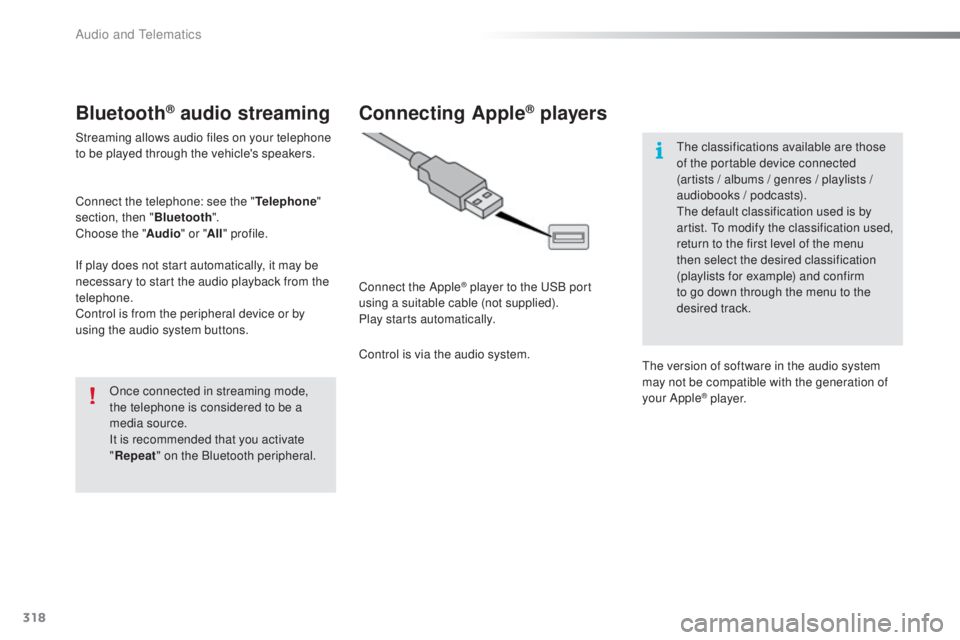
318
308_en_Chap10c_SMegplus_ed02-2015
Bluetooth® audio streaming
Streaming allows audio files on your telephone
to be played through the vehicle's speakers.
Connect the telephone: see the "Telephone"
section, then " Bluetooth".
Choose the " Audio" or "All" profile.
If play does not start automatically, it may be
necessary to start the audio playback from the
telephone.
Control is from the peripheral device or by
using the audio system buttons.
Once connected in streaming mode,
the telephone is considered to be a
media source.
It is recommended that you activate
"Repeat " on the Bluetooth peripheral.
Connecting Apple® players
Connect the Apple® player to the uSB p ort
using a suitable cable (not supplied).
Play starts automatically.
Control is via the audio system.
the c
lassifications available are those
of the portable device connected
(artists / albums / genres / playlists /
audiobooks / podcasts).
the d
efault classification used is by
artist.
to mo
dify the classification used,
return to the first level of the menu
then select the desired classification
(playlists for example) and confirm
to go down through the menu to the
desired track.
the v
ersion of software in the audio system
may not be compatible with the generation of
your Apple
® p l aye r.
Audio and telematics
Page 323 of 398
321
308_en_Chap10c_SMegplus_ed02-2015
Level 1Level 2 Level 3 Comments
Navigation Settings
Navigation Enter destination
Display recent destinations.
Calculatory criteria Fastest
Choose the navigation criteria.
the m
ap displays the route chosen according to
these criteria.
Shortest
time
/distance
eco
logical
to l
l s
Ferries
Strict - Close
Show route on map Display the map and start navigation.
Confirm Save the options.
Save Save the current address.
Stop navigation Delete the navigation information.
Voice Choose the volume for voice and announcement
of street names.
Diversion Detour from your initial route by a certain
distance.
Navigation Display in text mode.
Zoom in.
Zoom out.
Display in full screen mode.
use t
he arrows to move the map.
Switch to 2D map.
.
Audio and telematics
Page 353 of 398
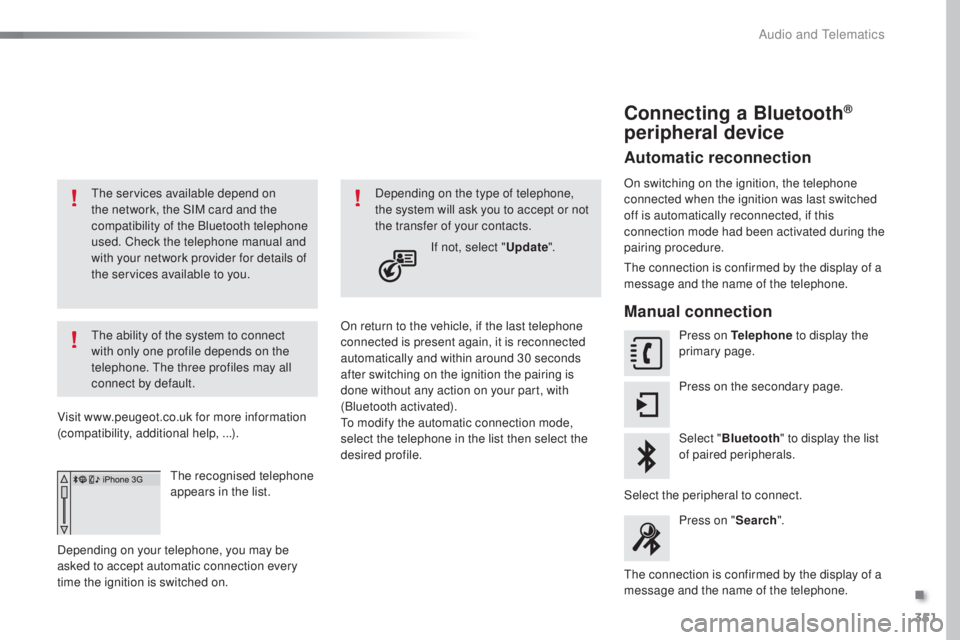
351
308_en_Chap10c_SMegplus_ed02-2015
the services available depend on
t he network, the SIM card and the
compatibility of the Bluetooth telephone
used. Check the telephone manual and
with your network provider for details of
the services available to you.
the a
bility of the system to connect
with only one profile depends on the
telephone.
the
three profiles may all
connect by default.
Visit www.peugeot.co.uk for more information
(compatibility, additional help, ...).
the r
ecognised telephone
appears in the list.
Depending on your telephone, you may be
asked to accept automatic connection every
time the ignition is switched on. On return to the vehicle, if the last telephone
connected is present again, it is reconnected
automatically and within around 30 seconds
after switching on the ignition the pairing is
done without any action on your part, with
(Bluetooth activated).
to mo
dify the automatic connection mode,
select the telephone in the list then select the
desired profile. Depending on the type of telephone,
the system will ask you to accept or not
the transfer of your contacts.
If not, select " Update".
Connecting a Bluetooth®
peripheral device
Automatic reconnection
On switching on the ignition, the telephone
connected when the ignition was last switched
off is automatically reconnected, if this
connection mode had been activated during the
pairing procedure.
the c
onnection is confirmed by the display of a
message and the name of the telephone.
Manual connection
Press on Telephone to display the
primary page.
Press on the secondary page.
Select " Bluetooth " to display the list
of paired peripherals.
Select the peripheral to connect. Press on " Search".
the c
onnection is confirmed by the display of a
message and the name of the telephone.
.
Audio and telematics